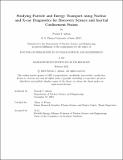Studying Particle and Energy Transport using Nuclear and X-ray Diagnostics for Discovery Science and Inertial Confinement Fusion
Author(s)
Adrian, Patrick J.
DownloadThesis PDF (25.70Mb)
Advisor
Frenje, Johan A.
Terms of use
Metadata
Show full item recordAbstract
Obtaining a fundamental understanding of particle and energy transport in High Energy Density Plasmas (HEDP) is essential for advancing basic plasma science and for correctly modeling the energy balance and ignition threshold in Inertial Confinement Fusion (ICF) implosions. Particle and energy transport in HEDP and ICF have therefore been the subject of extensive analytical and numerical studies over decades. In contrast, only a very limited set of experimental data exists to test these theories. The lack of data is generally due to the dynamic and complex nature of HEDP and ICF implosions, seriously compromising any methods that try to directly relate observables to the transport processes. To address this issue, we present a new set of diagnostics and experimental platforms that were implemented and used to uniquely probe three transport processes relevant to HEDP and ICF implosions: low-velocity ion-stopping power, the ion-electron energy exchange, and ion inter-diffusion. The experiments utilized one-dimensional, shock-driven implosions of D³He gas-filled thin-glass capsules to reach conditions relevant to ICF. In the first set of experiments, low-velocity ion stopping was measured and used to constrain the ion-electron energy exchange cross section at plasma conditions similar to the hot spot in ICF ignition experiments. The data agreed with quantum mechanical treatment of ion-electron energy-exchange cross section, which includes the diffraction of electrons [1]. In the second experiment, the mixing between the glass shell and D³He fuel due to plasma inter-diffusion was explored. This experiment utilized enhanced x-ray emission from the glass mixed into the hot spot, and the resulting data was used to validate different ion-diffusion models. The observed x-ray emission was modeled with an ion-Fokker Planck code, indicating that a significant component of the mix is due to kinetic streaming of the different ion species rather than collisional diffusion. Overall, these experiments have advanced our understanding of particle and energy transport in HEDP, which is critical for modeling the energy balance and ignition threshold in ICF implosions.
Date issued
2024-02Department
Massachusetts Institute of Technology. Department of Nuclear Science and EngineeringPublisher
Massachusetts Institute of Technology